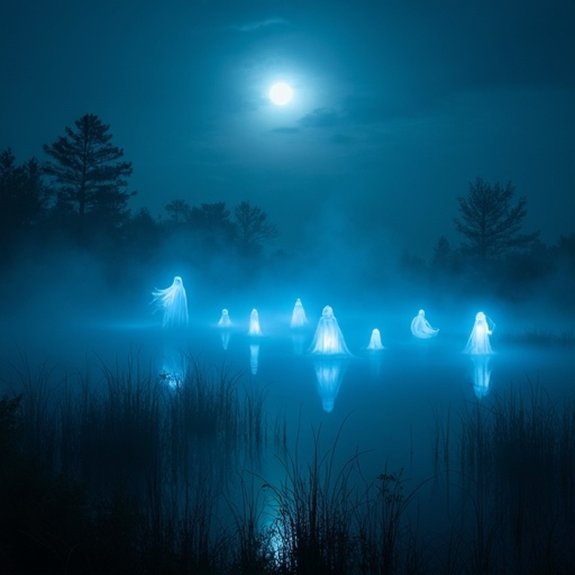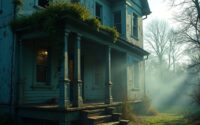Ghost Lights: Will-O’-The-Wisp Vs Spirits
The flickering lights that’ve haunted marshlands and forests for centuries spark an enduring debate between believers and skeptics. Scientists point to methane combustion and phosphorescent gases, while witnesses swear they’ve encountered something otherworldly. These mysterious illuminations appear worldwide, each culture offering its own interpretation of what dances just beyond reach. The truth about ghost lights remains elusive, trapped somewhere between laboratory explanations and ancient warnings whispered through generations.
Introduction

When mysterious lights appear in darkness without explanation, they’ve captivated human imagination for centuries, sparking debates about whether they’re natural phenomena or supernatural manifestations. These enigmatic glows, commonly called ghost lights or will-o’-the-wisps, have appeared in folklore across every continent. Scientists attribute many sightings to natural causes like swamp gas igniting spontaneously, bioluminescent organisms, or atmospheric conditions creating optical illusions. However, believers in the paranormal insist some lights can’t be explained by science alone. They argue certain ghost lights display intelligent behavior, following observers or responding to human presence. The distinction between natural will-o’-the-wisps and alleged spirit lights remains contentious. This ongoing mystery continues to fuel scientific research while preserving humanity’s fascination with the unexplained phenomena that flicker just beyond understanding’s reach.
Ancient Folklore Across Continents
Ghost lights have haunted human stories since ancient times, with nearly every culture developing its own interpretation of these mysterious phenomena. European folklore called them will-o’-the-wisps, believing they were mischievous spirits that’d lead travelers astray into marshes and bogs. The Japanese knew them as hitodama—souls of the recently deceased floating as glowing orbs.
In South America, the luz mala represented evil spirits wandering the countryside, while Aboriginal Australians saw min min lights as ancestral warnings. African traditions linked ghost lights to witchcraft and restless dead. Despite geographical separation, these cultures shared remarkably similar beliefs: the lights weren’t natural but supernatural, often connected to death, deception, or divine messages. This universal recognition suggests humanity’s long-standing need to explain the unexplainable through spiritual narratives.
Notable Cases or Sightings

Since the late 1800s, the Marfa Lights in Texas have captivated thousands of witnesses who’ve reported seeing basketball-sized orbs dancing across the desert horizon. These mysterious lights appear nightly near Route 67, splitting, merging, and vanishing without explanation.
North Carolina’s Brown Mountain Lights predate European settlement, with Cherokee legends describing the phenomena centuries before scientists attempted investigations in 1913. The lights manifest as reddish orbs rising above the ridge line.
Australia’s Min Min Lights terrorize Queensland’s Channel Country, where drivers report being followed by floating lights that match their speed. Japan’s Shiranui phenomenon creates blue-white flames over the Yatsushiro Sea, historically interpreted as dragon lanterns.
Scientists can’t definitively explain these sightings. While some propose atmospheric plasma or car headlights, the lights’ behavior often defies conventional physics.
Common Theories or Explanations
Although skeptics and believers clash over ghost lights’ origins, researchers have proposed several scientific mechanisms that might explain these phenomena. Swamp gas remains the most cited explanation—methane and phosphine gases from decaying organic matter can spontaneously ignite, creating fleeting lights above marshlands. Scientists also point to piezoelectric effects, where tectonic stress generates electrical fields that manifest as luminous balls.
Atmospheric conditions create other possibilities. Temperature inversions can refract distant headlights or city lights, making them appear to hover mysteriously. Ball lightning, though rare, produces glowing spheres that drift through air. Some researchers suggest bioluminescence from fungi or insects might account for certain sightings. These theories don’t explain every encounter, but they’ve successfully replicated ghost light characteristics in laboratory settings.
Frequently Asked Questions
Can Ghost Lights Be Photographed or Captured on Video?
Yes, people’ve photographed and filmed various ghost lights worldwide. Natural phenomena like will-o’-the-wisps appear in photos as glowing orbs or streaks. However, scientists debate whether captured images show genuine unexplained lights or camera artifacts and misidentifications.
Are Ghost Lights Dangerous to Humans Who Encounter Them?
They’re typically not dangerous, though historical accounts describe people getting lost following them into marshes. Scientists explain most encounters as harmless optical phenomena, while folklore warns they’ll lead travelers astray into treacherous terrain.
What Time of Year Are Ghost Lights Most Commonly Reported?
Ghost lights are most commonly reported during autumn months, particularly October and November. Witnesses frequently spot them on foggy nights when moisture levels peak. They’re also prevalent during summer’s humid evenings in marshy areas.
Do Animals React Differently to Ghost Lights Than Humans?
Animals often flee or show agitation when ghost lights appear, while humans typically approach them out of curiosity. Dogs bark frantically, horses won’t cross paths where lights appear, and birds avoid areas with recurring sightings.
How Can You Tell the Difference Between Ghost Lights and Regular Lights?
Ghost lights don’t cast shadows, flicker unnaturally, and move against wind patterns. They’ll appear in unlikely places like swamps or forests, often changing colors. Regular lights maintain consistent brightness, create shadows, and have identifiable sources.


